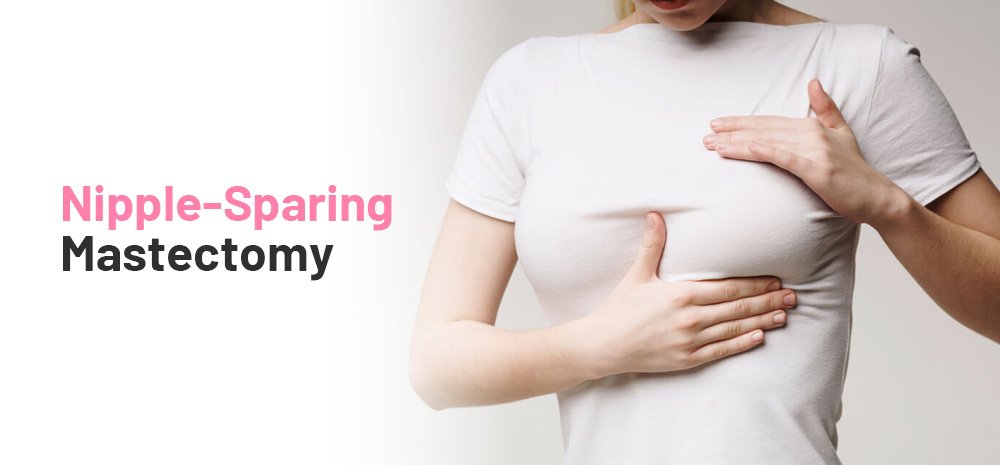
Nipple Sparing Mastectomy Procedure
A nipple-sparing mastectomy is a surgical procedure in which the breast tissue is removed, but the nipple and areola are left intact along with the skin envelope. This type of mastectomy is typically used for women who have been diagnosed with breast cancer and wish to preserve the appearance of their breast. The procedure is more complex than a traditional mastectomy, and not all women are candidates for it. It is usually done in combination with breast reconstruction surgery.
Why is nipple-sparing mastectomy done?
Nipple-sparing mastectomy is typically done for women who have been diagnosed with breast cancer and wish to preserve the appearance of their breast after surgery. This type of mastectomy can result in a more natural-looking breast shape and can also help to preserve sensation in the nipple and areola.
Additionally, it is also done for women who have high risk of breast cancer or genetic predisposition to breast cancer, where prophylactic (preventative) mastectomy is done to remove the breast tissue to lower the risk of developing breast cancer. It is important to note that not all women are candidates for nipple-sparing mastectomy, as the technique is more complex, and the nipple and areola must be free of cancer for the procedure to be safe.
What happens before nipple-sparing mastectomy surgery?
Before a nipple-sparing mastectomy surgery, the patient will typically have a consultation with a surgeon to discuss the procedure and determine if they are a candidate for the surgery. The patient will also have a mammogram or other imaging tests to check the breast tissue and ensure that the cancer has not spread to the nipples. The patient may also meet with a plastic surgeon to discuss reconstruction options. The patient will also be given instructions on preparing for the surgery, such as fasting the night before the procedure.
What happens after nipple-sparing mastectomy surgery?
After a nipple-sparing mastectomy surgery, the patient will typically spend some time in recovery before being discharged from the hospital. To treat any discomfort, the patient will be given painkillers, and drains may be inserted to clear the surgical site of extra fluid. For several weeks as the incision site heals, the patient will be advised to refrain from heavy lifting and intense activities. To track their progress and make sure the cancer has been completely removed, the patient will also need to go to follow-up consultations with the surgeon. If reconstruction is done with breast implant, the patient will need to attend follow-up appointments with the plastic surgeon to monitor the healing of the implant and the shape of the breast.
How to prepare for nipple-sparing mastectomy surgery?
Nipple-sparing mastectomy is a surgical procedure that removes the breast tissue while preserving the nipple and areola. To prepare for this surgery, it is important to:
- Consult with a surgeon who is experienced in performing nipple-sparing mastectomy.
- Get a thorough physical examination and any necessary tests, such as a mammogram or MRI, to evaluate the breast tissue.
- Discuss any medical conditions or medications that you are taking with your surgeon.
- Stop smoking and avoid taking certain medications, such as blood thinners, as instructed by your surgeon.
- Arrange for someone to drive you home and help you with daily tasks during your recovery.
- Understand the risks and benefits of the surgery and have realistic expectations about the outcome.
It is also important to understand that the success of nipple-sparing mastectomy depends on the size and location of the tumor, as well as the overall health of the patient and the expertise of the surgeon.
What to do after nipple-sparing mastectomy surgery?
It’s crucial to adhere to your surgeon’s recommendations for recovery and aftercare after a nipple-sparing mastectomy. This might comprise:
- Rest at home and avoid strenuous activities or heavy lifting for some time.
- Wearing a surgical bra or compression garment as instructed by your surgeon to help support the chest and reduce swelling.
- Managing pain and discomfort with medication as prescribed by your surgeon.
- Keeping the incision area clean and dry, and avoiding soaking in water (such as in a bath or pool) until instructed otherwise.
- Monitoring for signs of infection, such as redness, swelling, or discharge from the incision site.
- Following a healthy diet and drinking plenty of water to help with healing and recovery.
- Scheduling follow-up appointments with your surgeon to monitor your progress and address any concerns.
The operation for NSM normally takes two to three hours and is typically carried out under general anesthesia. Individual recovery times following NSM vary; however, most people can resume their regular activities in four to six weeks.
Recoveries might take various periods for different people, so patience’s vital during the process. Additionally, you might have to wait a specific amount of time before getting breast reconstruction or breast prosthesis.
Additionally, you should be informed that your breast sensation can temporarily change and that your surgeon might suggest you refrain from sexual activity for a while.
Final Comments
Dr. Mansi Chowhan is a renowned surgical oncologist with more than 12 years of experience. She received a gold medal for her exceptional achievement during her postgraduate studies. She is a highly skilled surgeon who specialises in breast oncoplastic surgery, head and neck surgery, and reconstructive procedures. During her more than 12 years of medical practice (NCR), she has worked at some of Delhi-National Capital Region’s most famous hospitals.
For any breast-related queries, you can consult here!
More Expertise
EXCELLENT






